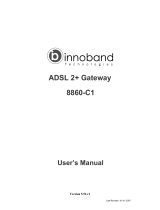1
Chapter 1: Introduction
Welcome
Wireless-G ADSL Home Gateway
Chapter 1: Introduction
Welcome
Thank you for choosing the Wireless-G ADSL Home Gateway. This Gateway will provide your computers with a
high-speed Internet connection as well as resources, including files and printers. Since the Gateway is wireless,
Internet access can be shared over the wired network as well as the wireless broadcast at up to 11Mbps for
Wireless-B or up to 54Mbps for Wireless-G.
How does the Gateway do all of this? By connecting the Internet, as well as your computers and peripherals, to
the Gateway, then the Gateway can direct and control communications for your network.
To protect your data and privacy, the Gateway features an advanced firewall to keep out Internet intruders.
Wireless transmissions can be protected by powerful data encryption. In addition, you can safeguard your family
with parental control features such as Internet access restrictions and keyword blocking. You can configure the
Gateway’s settings through the easy-to-use, browser-based utility.
But what does all of this mean?
Networks are useful tools for sharing Internet access and computer resources. You can access one printer from
different computers and access data located on another computer’s hard drive. Networks are even used for
playing multiplayer video games. So, networks not only are useful in homes and offices, but also can be fun.
PCs on a wired network create a LAN, or Local Area Network. They are connected with Ethernet cables, which is
why the network is called “wired”. PCs equipped with wireless cards or adapters can communicate without
cumbersome cables. By sharing the same wireless settings, within their transmission radius, they form a
wireless network. This is sometimes called a WLAN, or Wireless Local Area Network. Since the Gateway has
wireless capabilities, it can bridge your wired and wireless networks, letting them communicate with each other.
With your networks all connected, wired, wireless, and the Internet, you can now share files and Internet
access—and even play games. All the while, the Wireless-G ADSL Home Gateway protects your networks from
unauthorized and unwelcome users.
Linksys recommends using the Setup CD-ROM for first-time installation of the Gateway. If you do not wish to run
the Setup Wizard on the Setup CD-ROM, then use the instructions in this Guide to help you connect the Gateway,
set it up, and configure it to bridge your different networks. These instructions should be all you need to get the
most out of the Wireless-G ADSL Home Gateway.
lan (local area network): The computers and
networking products that make up the network in
your home or office.
nat (network address translation): NAT technology
translates IP addresses of a local area network to a
different IP address for the Internet.
wpa (wi-fi protected access): a wireless security
protocol using TKIP (Temporal Key Integrity Protocol)
encryption, which can be used in conjunction with a
RADIUS server.
spi (stateful packet inspection) firewall: a technology
that inspects incoming packets of information before
allowing them to enter the network.
firewall: Security measures that protect the
resources of a local network from intruders.
network: a series of computers or devices
connected for the purpose of data sharing,
storage, and/or transmission between users





















